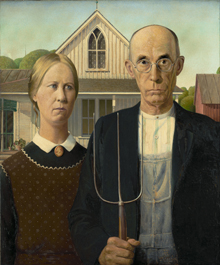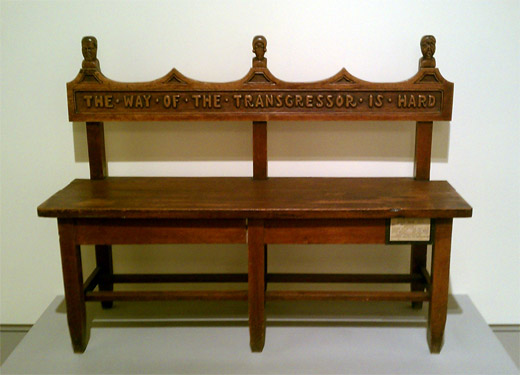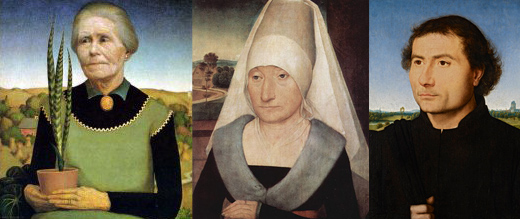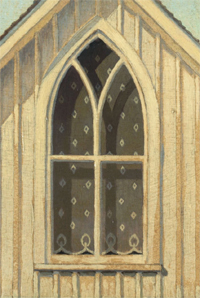 Fireworks! Barbecues! The Fourth of July approacheth, and as Americans dwell on traditions, origins, and independence from the Old World, it’s a fine time to reconsider American Gothic. Everyone knows the painting, but few people really look at it—but when you do, you’ll find that Grant Wood uses serious medievalism to find humor in a 200-year identity crisis.
Fireworks! Barbecues! The Fourth of July approacheth, and as Americans dwell on traditions, origins, and independence from the Old World, it’s a fine time to reconsider American Gothic. Everyone knows the painting, but few people really look at it—but when you do, you’ll find that Grant Wood uses serious medievalism to find humor in a 200-year identity crisis.
Wood based his painting around a modest house in Eldon, Iowa, whose only flourish was a Gothic window he found both delightful and pretentious. Wood’s sister and a local dentist posed as the sorts of people he imagined would live in such a house; most of the time, Wood insisted that his characters were father and daughter, not husband and wife. The painting was a smash at both a 1930 Art Institute of Chicago exhibition and the 1933 World’s Fair, and in 1934 the entire country saw American Gothic in full color in Time magazine.
Art historian Thomas Hoving has pointed out the painting’s clever composition: how the top of the middle pitchfork tine marks the center of the painting; how the three tines are echoed in the stitching of the man’s overalls and in the window tracery; how the bulb at the top of the lightning rod echoes the button on the man’s collar; and how the lines of the peaked roof point directly to the man and the woman. “The house and the couple are utterly unified, like the statues on thirteenth-century cathedrals,” Hoving writes—which is appropriate, because it’s remarkable how European American Gothic actually is.
Grant Wood’s name normally evokes the Midwest, not the Middle Ages. After a stint in France and a fling with Impressionism, Wood hurried back to his Iowa home and happily let the press turn him into the champion of a new regionalism in American art. He donned overalls, sought out local subjects, and created an icon of Americana that either enshrines or mocks its subjects, depending on your point of view. “The farther a critic lived from the Midwest, the more predisposed he or she was to read the painting as satire or social criticism,” one art historian quipped about American Gothic—but what if most viewers for 80-odd years have focused way too much on the “American” and not nearly enough on the “Gothic”?
Quoth Wood biographer R. Tripp Evans: “Wood’s attraction to the Arts and Crafts movement—which advocated hand craftsmanship, rural simplicity, and even the revival of the guild system—had led him from an early age to associate his work with that of medieval artisans.” Yes, but Wood didn’t just imitate the medieval past; he found humor in comparing the Middle Ages and modern America. Last year at the Cedar Rapids Art Museum, I got a kick out of Wood’s “Mourner’s Bench,” a medieval church pew that stood outside the principal’s office at the local junior high. (The tops of the posts are faces: two disciplinarians and a wailing student.)

“The lovely apparel and accessories of the Gothic period appealed to me so vitally,” Wood wrote, “that I longed to see pictorial and decorative possibilities in our contemporary clothes and articles.” One art historian points out that Wood was fascinated by late Northern Gothic painters, especially 15th-century German-born Flemish artist Hans Memling. When you put some Memling portraits alongside Woman with Plants, Wood’s painting of his mother, it’s clear what he was imitating—the landscape, the poses, the stark black clothing and cloudless blue skies—with humor implicit in the comparison.

Other art historians have listed Wood’s many medieval and early Renaissance influences. Biographer R. Tripp Evans finds that the tiny bathing figures in Arnold Comes of Age (below left) look like miniature depictions of Adam and Eve being expelled from Paradise in the backgrounds of Nativity and Crucifixion scenes on medieval altarpieces, and he points out that Wood’s huge Dinner for Threshers evokes the Last Supper and mimics a medieval triptych. In Adoration of the Home (below right), Wood expert Wanda Corn sees a medieval altarpiece with a Madonna and Child surrounded by saints.

After Wood died in 1942 at the age of 50, trendier critics condemned him as nationalistic and reactionary, and some ludicrously likened his work to Nazi art. The joke’s on them: They missed the centuries-old motifs that linked Wood’s “regionalism” to traditions more venerable than most of the century’s fads.
Then again, they were only doing what most of us do: obsessing over the American while ignoring the Gothic. Photographer Gordon Parks was the first to parody the painting in 1942, and since then it’s become a boon for lazy political cartoonists, ad agencies, movie-poster designers, and anyone who wants to suggest that a stuffy, old-fashioned sensibility is being tweaked, surpassed, desecrated, defied, or redefined. Nothing is more establishmentarian than parodying American Gothic.
…and while everyone looks at the people in the painting, no one considers that silly little window behind them.
 According to his recent biographer, Wood focused on arched windows and doors in his early French paintings, and he specifically said that American Gothic was meant to feature “American Gothic people” whose features complemented architecture that emphasized vertical lines. “These particulars, of course, don’t really matter,” Wood wrote in a 1941 letter. “What does matter is whether or not these faces are true to American life and reveal something about it. It seemed to me that there was a significant relationship between the people and the false Gothic house with its ecclesiastical window.”
According to his recent biographer, Wood focused on arched windows and doors in his early French paintings, and he specifically said that American Gothic was meant to feature “American Gothic people” whose features complemented architecture that emphasized vertical lines. “These particulars, of course, don’t really matter,” Wood wrote in a 1941 letter. “What does matter is whether or not these faces are true to American life and reveal something about it. It seemed to me that there was a significant relationship between the people and the false Gothic house with its ecclesiastical window.”
Wood toyed with the idea of a companion painting that would have put squat Americans in front of the horizontal lines of Mission architecture, but of course he never created it—because he was beguiled by the Gothic, as two generations before him had been.
By 1930, America was coming off a multi-decade Gothic Revival bender. Since the second half of the 19th century, architects across the country had been dreaming up American Gothic buildings: churches, cathedrals, college campuses, prep schools, factories, skyscrapers, courthouses, apartments, at least one synagogue, and even crummy “Carpenter Gothic” houses like the one in Eldon. Their neo-medieval look was sometimes democratic, sometimes aristocratic, sometimes religious, sometimes secular, old and European but American and new. It’s a fine, precarious ambivalence: Are we making a New World here, or not?
Wood’s painting is satiric, but it pokes fun at pretensions that weren’t (and still aren’t) confined to the Midwest. Sometimes, Americans aspire to be medieval; other times, we’re medieval by accident. What’s great about American Gothic is that Grant Wood, however fond he is of his subjects, exposes them to democratic judgment. Each of us gets to look over the heads of two imaginary Iowans and decide for ourselves whether our collective pretensions are noble or foolish, or if we really are late Gothic people just posing in latter-day garb.

Hello,
I enjoyed reading your post regarding Grant Wood. It is always nice to come across more interpretations of his work. Though unintentional, I would like to thank you for your feedback regarding our website. I do not believe it is our intention to assume visitors to our museum are more interested in having their photograph taken than to learn the history of the house, Grant Wood, or his work. Though we do have some visitors who see this stop as a roadside attraction, the majority of visitors come with a genuine interest in learning more about the American Gothic House. However, the photographs do serve more of a purpose than merely a trite parody–the photograph and costumes are an immersive, educational experience. Many visitors realize more elements once they put themselves in the painting, which opens a dialogue to discuss the work’s intricacies.
We are currently developing a new website which will go live next week (which will make the link used to our site no longer available). It is my hope our new website will be more enriching and not give the impression of an institution you describe.
Thank you,
Holly Berg
Administrator
American Gothic House Center
LikeLike
Thanks for stopping by, Holly! I spent more time looking at your website, and I decided: You’re right. I misrepresented the focus of your organization, especially given how art-focused your blog is, so I’ve deleted the inaccurate sentence, and I’d strongly encourage readers who enjoyed this post to visit the American Gothic House Center website and follow your blog. You’re doing good stuff, and I’m happy to support your work.
LikeLike
Hi Jeff,
Very interesting piece–the translation of the European into the New World is always fascinating, and I loved the descriptions of the paintings.
LikeLike